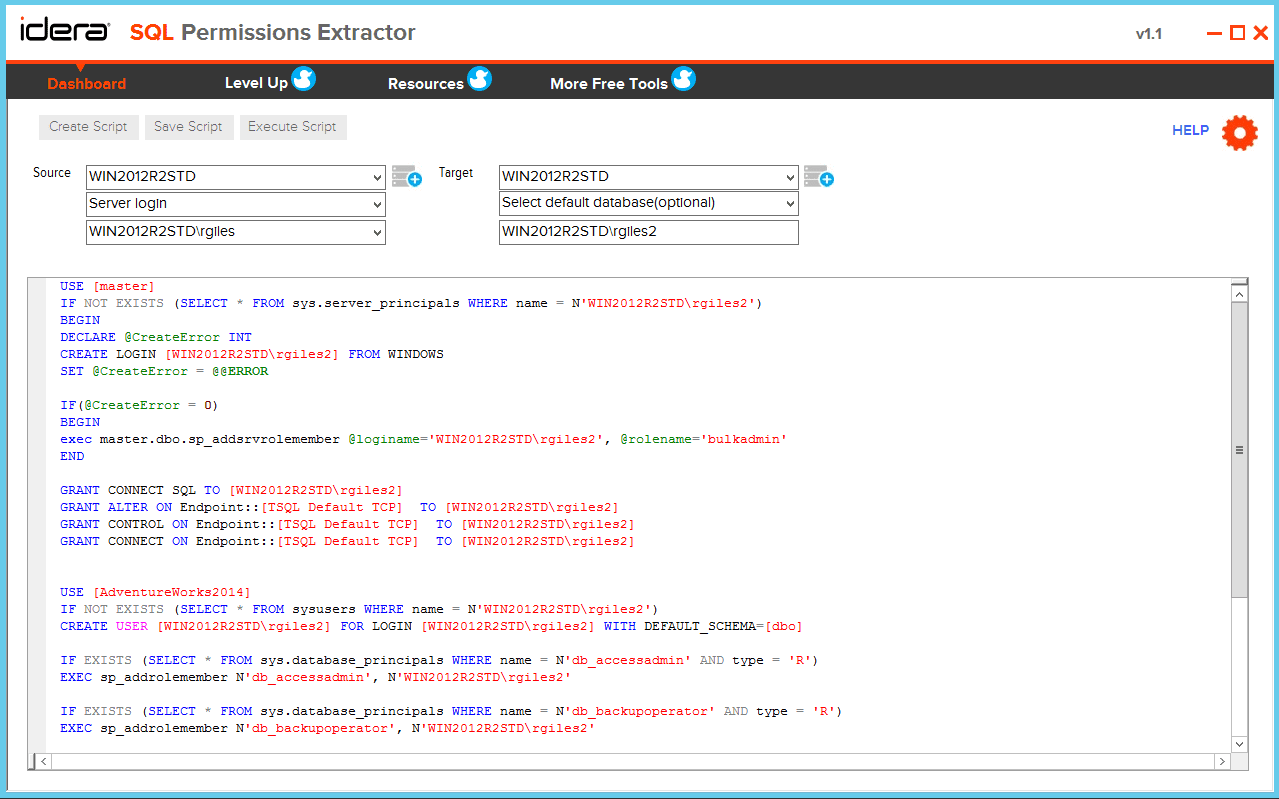Free Tool – SQL Permissions Extractor
User Permissions Migration for SQL Server, Azure SQL Database, and Amazon RDS for SQL Server
Copy user permissions across database versions and editions
Ultimately, it enhances organizational productivity, maintains user trust, and aligns with best-practice security protocols.
Download the free PowerShell scripts for SQL Server now!
Reduce the likelihood of errors by assisting users to manage and replicate permissions of SQL Servers.
Simplify the process, reduces the burden, and saves time by adopting a four-step mechanism to duplicate logins.
Enable users to edit extracted T-SQL scripts for permissions, preventing issues from manual adjustments before SQL Server implementation.
Ease migrations between different editions and versions of SQL Server via its cross-compatible feature.
Deploy the free tool without installing anything on the affected database instances.
What Is New in SQL Permissions Extractor 1.2:
The release of SQL Permissions Extractor version 1.2 in 2024 focuses on addressing numerous customers submitted suggestions and adding quality enhancements to the application:
Connecting to instances via Azure Active Directory to supplement SQL Authentication and Windows Active Directory
Displaying the graphical user interface properly at different screen sizes and for all high resolution monitors
Better usability of the application by refining and reinforcing its overall functionality
Bug fixes
Tech Specs
Desktop Console
- Microsoft Windows: Vista SP1, Server 2008 (not supported on Server Core Role), 7, Server 2008 R2 (not supported on Server Core Role); 8, Server 2012, 8.1, Server 2012 R2, 10, Server 2016, Server 2019; plus 11, Server 2022 (provisional); 64-bit, 32-bit
- Microsoft .NET Framework: 4.0 and later
- web browser: Microsoft Internet Explorer 10.x+ (minimum of Windows 7 SP1, Server 2008 R2 SP1), Microsoft Edge, Google Chrome, Mozilla Firefox
Database Platforms
- Microsoft SQL Server: 2008 R2, 2012; 2014, 2016, 2017, 2019; plus 2022 (provisional); Windows, Linux; Express, Standard, Enterprise editions
Databases in the Cloud
- Microsoft Azure: Virtual Machine (VM)
- Amazon Web Services: Elastic Compute Cloud (EC2), Relational Database Service (RDS); cannot target Amazon RDS system databases
- connection: DNS domain name, IP address; SQL Authentication, Windows Active Directory, Azure Active Directory
Agentless
- SQL Permissions Extractor does not install any components, dynamic link libraries (DLLs), scripts, stored procedures, or tables on the managed database instances.
Generate T-SQL scripts for Copying of User Permissions
Copy user permissions across various versions of SQL Server and clone user permissions within the same server.
Edit, Save, and Execute Permissions Scripts
After generating a permissions script, apply this script to any object or server in your SQL Server environment.
Include Object-level Permissions for Selected Databases
Drill down, select, and copy permissions for specific databases within your SQL Server.
Four Steps to Copy, Extract, Modify, and Apply Changes
Simply select a SQL Server login, script the permissions associated with the selected login, modify that script, and apply the permissions to a target SQL Server
No Agents Required on Managed Instances
Installing agents on SQL Server instances can be tedious and invasive. And agents installed on monitored SQL Server instances can impact performance. SQL Permissions Extractor does not require installing an agent on the monitored instances.
Connect to the Cloud and Run In the Cloud
Connect to database instances hosted on cloud virtual machines, such as SQL Server on Azure Virtual Machine (VM) and SQL Server on Amazon Elastic Compute Cloud (EC2).
Connect to the managed cloud databases Azure SQL Database and Amazon Relational Database Service (RDS) for SQL Server.
Install and run on virtual machines hosted in the cloud, such as Windows on Azure Virtual Machine (VM) and Windows on Amazon Elastic Compute Cloud (EC2).
